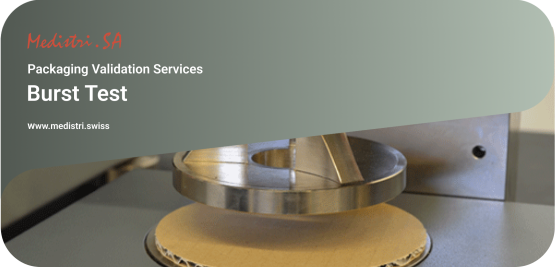(Download: Burst Test in PDF by Medistri)
The Burst Test, as defined by the International Organization for Standardization (ISO) in ISO 2758, is a globally recognized method for assessing the bursting strength of paper. This test, also known as the Mullen Test, is applicable to paper with bursting strengths ranging from 70 kPa to 1,400 kPa.
The Burst Test is a method used to measure the bursting strength of paper. It involves applying increasing hydraulic pressure to a piece of paper until it bursts. The pressure at which the paper bursts is recorded as its bursting strength.
The Burst Test is important for several reasons:
- Quality Control: It helps manufacturers ensure the quality of their paper products. By measuring the bursting strength of paper, manufacturers can determine if their products meet the necessary standards and are fit for use.
- Product Development: The test can also be used in product development to compare the strength of different types of paper and to make improvements where necessary.
- Consumer Confidence: Products that have been tested and meet certain standards provide assurance to consumers about their quality and reliability.
- Regulatory Compliance: Many industries have regulations requiring products to meet certain standards. The Burst Test can help ensure that paper products comply with these regulations.
There’s a group of conditions and rules that must be followed to perform a Burst Test, in order to achieve the most accurate and detailed procedure:
- Apparatus Setup: Ensure that the testing apparatus is properly set up and calibrated.
- Sample Preparation: Prepare the paper samples that you want to test. The Burst Test is applicable to paper with bursting strengths ranging from 70 kPa to 1,400 kPa. Cut the test pieces from the selected samples. The size of the test pieces will depend on the specifications of the testing apparatus.
- Conditioning: Condition the test pieces at a specific temperature and humidity before testing. This is to ensure that the results are not affected by environmental conditions.
- Testing: Place the test piece over a circular elastic diaphragm, rigidly clamped at the periphery but free to bulge with the diaphragm. Hydraulic fluid is pumped at a constant rate, bulging the diaphragm until the test piece ruptures. The bursting strength of the test piece is the maximum value of the applied hydraulic pressure.
- Results: Record the pressure at which the paper bursts as its bursting strength.
ISO 2758:2014 is an international standard that specifies a method for measuring the bursting strength of paper submitted to increasing hydraulic pressure. It is applicable to paper having bursting strengths within the range of 70 kPa to 1,400 kPa. The standard is not intended to be used for the components of a combined board, such as fluting medium or linerboard, for which the method given in ISO 2759 is more suitable.
The standard includes sections on the principle of the test, the apparatus used, calibration, sampling and preparation of test pieces, the procedure, expression of results, and the test report. The standard was last reviewed and confirmed in 2020, so the current version remains ISO 2758:2014.
For materials with bursting strengths equal to or greater than 350 kPa (or 250 kPa for the components of combined materials), an alternative method, based on similar principles, is specified in ISO 2759. All components of solid and corrugated fibreboard, irrespective of bursting strength, should be tested according to ISO 2759.
🎯 To learn more about Medistri’s Burst Test, visit on our website here or directly contact our team at contact@medistri.swiss.
- The Medistri Team
#Medistri
